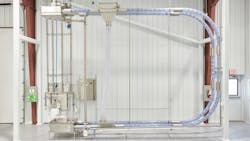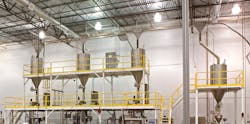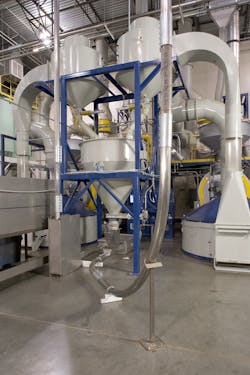For food processing companies with high-value product susceptible to damage such as nuts, cereal, coffee, snacks and dry pet food, material breakage and loss is a very costly problem that can harm the bottom line. Even a difference between 1% waste and 5% can mean the difference between profit or loss.
To convey such delicate food product, processors should avoid conveyors that may force the fragile material through stressful phases during transport that could impact its integrity, while still meeting high throughput requirements. Given this need, some food processors are reconsidering conveying fragile, high-value products using high-velocity air power through tubes, bends or sweeps before it is unceremoniously dumped into bins or containers.
In the coffee industry, for example, processors go to great expense to roast whole beans. However, the beans can be damaged by high velocity air conveyance, compromising flavor and aroma, according to Gary Schliebs, a Process Engineer and Director of Plus One Percent…Engineered Solutions, a consulting firm that works in the food processing industry and markets food industry conveyor equipment globally.
When a whole macadamia nut is broken, its value can drop by half. Instead of a premium price for whole nuts, damaged nuts are often sold at a substantial discount, and often crushed for use in cooking or processing further upstream in the food industry.
“Many high-value food products can be fragile and need very gentle handling. Otherwise, whole forms can be broken, crushed to bits and even turned to powder. This significantly lowers the value of the product, and damaged portions may need to be removed or disposed of to prevent perceived quality issues that could prompt customers to turn to other brands,” says Schliebs.
“In some cases, more than 10% of delicate product can be damaged by high velocity air-power systems. The cost to the industry is compounded because the damage often comes at the end of the process, after considerable value has been added, only to have it degraded by a poor choice in the selection of transfer conveying equipment,” adds Schliebs, who frequently consults on food engineering equipment design, plant layouts and process flows.
The limitations of air conveyors
A wide range of fragile, high-dollar-value food products can be prone to excess breakage when conveyed at high velocity by air power, such as in pneumatic and aeromechanical systems.
Pneumatic conveyor systems utilize air by creating air pressure above or below the atmospheric level. The two main types of pneumatic conveyors — dilute phase and dense phase — differ by speed and pressure, and both can be configured as a pressure or vacuum system.
In dilute phase conveying, the food product is suspended in the air as it is transported through the conveying pipe at extremely high velocities of typically 3,400-5,000ft/min. While the product usually has minimal breakage during straight pathways, most systems have bends and sweeps where it can be forced through constricted areas, quickly change direction and be damaged. In such cases, high-dollar-value food often can be too fragile.
Dense phase pneumatic conveyor systems, where the product is not suspended in air since it is heavy or abrasive, function at lower velocity than dilute phase. However, with air speeds of about 700-1,500ft/min., delicate food items are still susceptible to breakage at bends and sweeps.
While aeromechanical conveyors have a different method of conveyance, these enclosed, high-capacity mechanical systems can also degrade delicate product. With these systems, a wire rope with evenly spaced discs within a tube travels at high speed, running in sprockets at each end of the conveyor. This generates an internal air stream traveling at the same high velocity as the discs that carry product along in the tube. However, these conveyors may also force vulnerable materials through stressful phases during transport, which could impair their integrity.
“Any fragile or friable food product conveyed at high velocity is prone to damage, particularly if it changes direction or exits with impact. This can be the case with both pneumatic or aeromechanical conveyors,” says Schliebs.
A gentler approach boosts profitability
According to Schliebs, a gentler alternative to protect sensitive, high-value food products is to utilize tubular cable conveyors. These systems move product through a sealed tube using a coated, flexible stainless-steel drag cable pulled through on a loop. Solid circular discs (flights) are attached to the cable, which push the product at low speed through the tube without the use of air, preserving product integrity and minimizing waste.
“Food industry manufacturers can decrease product damage down to 1-2% with a slower process like a Cablevey Conveyors tubular cable system. With it, product is gently transferred at low speed, so there is minimal to no damage,” says Schliebs.
Cablevey Conveyors is an Oskaloosa, Iowa-based premium, specialty material moving, mechanical conveyor company that has designed, engineered and serviced enclosed cable and disc tube conveyors for almost 50 years, and is in more than 66 countries.
In the food industry, the conveyors are utilized for products such as nuts, cereal, coffee, snacks, pet food, beans and seeds. The systems can convey up to 2,000 cubic feet per hour (56m3/hr.) of flakes, pellets, shavings, crumbles, granules, regrind, chunks, parts, prills and powders with numerous layouts using multiple inlets and outlets.
Since the material is carried between the flights, it is also much easier to safely convey some sticky or easily compacted materials in a tubular cable conveyor than in air-powered conveying systems, where such materials can form plugs.
“With pneumatic or aero-mechanical conveying systems, any soft or sticky material, like dried fruit, can smear and adhere to surfaces, particularly at bends and sweeps that change direction, which is not an issue with tubular cable conveyors,” says Schliebs.
According to Schliebs, the tubular cable conveyor’s modular construction can also help reduce product damage by enabling it to slide out on a gentler gradient, rather than simply drop out, as is more typical with conveyors utilizing air.
“To minimize product damage, it is important for food industry manufacturers to not only transfer gently, but also get product in and out of the conveyor safely and gently as well. That is more achievable with a conveyor like Cablevey that allows product to slide down rather than drop out the end,” says Schliebs.
In fact, most tubular cable conveyors have interchangeable components that allow the conveyor to be easily expanded or reconfigured to change the length, conveying path and the number of inlets and outlets. These modifications are more complex and time-consuming with a pneumatic conveying system because it has more components and electrical connections.
Also, another bonus of the Cablevey systems is that the “footprint” can be quite small compared to other conveyor systems, which helps with tight and/or compact manufacturing areas.
“Because of the ‘bespoke’ design of each Cablevey system for customer-specific requirements, we can tailor the design to be very ‘non- intrusive’ in the work area and not hinder access for people and maintenance, as other systems can. This is a real bonus for safety, access and saving floor space, which is another cost to manufacturing,” said Schliebs.
Less energy use, less noise
Since pneumatic systems convey product at high velocity, this typically requires larger, power-hungry motors that run fans, blowers and rotary valves. In a dense phase system, a pressure tank requiring compressed air consumes additional power.
In terms of noise level, pneumatic conveying systems also generate considerable noise. Aero-mechanical systems, running at high speed, generate considerable motor and disc noise as well.
Given that smaller motors are used, tubular cable systems are quieter overall and utilize much less energy.
“A low-speed tubular cable system is quiet enough to easily have a conversation around it while it is running,” says Schliebs. “In regards to energy, it utilizes about one-tenth that of pneumatic systems. For dense phase models, the electricity savings by using a tubular conveyor can be sizeable, with one-year ROI in some cases.”
Del Williams is a technical writer based in Torrance, California.
Cablevey Conveyors
www.cablevey.com
About the Author
Del Williams
Del Williams is a technical writer based in Torrance, California.


